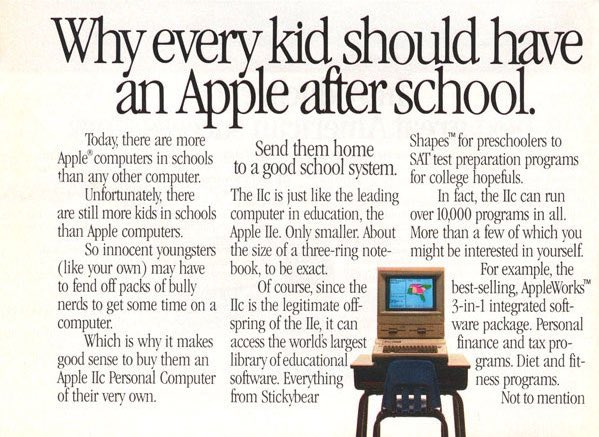Learning with technology
The country is at war with learning. Teachers, parents, and presidents are shouting at both technology companies for making things that kids play with and at the kids who engage with these products and or services. Discourse about the topic generally goes as follows ‘videogames are bad’, ‘no phones at school’, ‘no googling on your homework assignment’, ‘kids these days can’t put the games down!’. Convincing teachers, parents, and presidents that technology isn’t inherently bad for children would be a good first step in unbecoming at war with using technology to learn. The next step means rebuilding our schools and education systems around enhancing learning with technology. Allowing our kids to learn with technology would give us chance at not falling behind the rest of the planet in the decades to come. Societies that utilize technology to let their children learn will prosper in the new world. If the United States is serious about prosperity, technological progression, and abundance in the 21st century; teachers, parents, and presidents should be less focused on the jobs number and who they’re going to tax and become more focused on the quality and rate at which we are educating our country’s children. How do we do that? Some will argue for increases in general spending, or maybe paying teachers enough to convince people to forfeit other professions (which I would agree), or renaming schools1, or to change what information we are downloading into our kids at school2. The problem with the last point, for example, is that educating kids is not simply about picking and choosing which information we will teach them to learn. Kids learn through play and learning is much more about adventure and exploration than it is about information retention and teaching them what to think. The good news is that we have the technology now to dramatically enhance the quality and pace at which we learn how to think. Simply giving a child free access to a computer, with minimal adult intervention, allows that kid to engage, learn, and go wherever they find things they’re interested in throughout the vastness of the internet. We must ask how we can leverage technology in our schools to increase engagement and interest in learning, decrease the learn to money spent ratio, increase equality of opportunity and access to education, and unlock the true potential of America’s kids.
Technology unlocks human potential
When I was in the 8th grade almost a decade ago, there were two important rules in the classroom: no google to solve problems and Wikipedia was not to be trusted. We were learning history and pre-calculus and it was frowned upon to find help online lol. It was a more desirable path for our teachers to limit us to only use the textbook, to protect the efficacy of homework scores. Today, 8th-grade classrooms around the country are trying to ban Replit (where many young kids play, explore, and learn cs) because the kids don’t want to get off3. People are correct to argue that not all engagement is good engagement and platforms that are incentivized to keep people active on the platform for as long as possible are growing threats to our ability to focus, have a negative impact on consumers, and cause harm to society. However, just how we drive cars with the inherent risk of others putting us in danger by driving recklessly or fly planes with the inherent risk of a crash or equipment malfunction, we must look to use technology for the benefits that dramatically outweigh its perils. Replit should not be banned in schools because kids are engaged and interested in cs. Instead, its use should be rewarded if that’s what the child wants to play, engage, and learn with that day.
Technology makes equality of opportunity in education a realistic objective
Arguably the most important variable to America’s success in the future will be the percentage of American children who can give access to high-quality learning opportunities and education. Fortunately, with high-speed internet and a computer, this is possible. High-quality internet and a decent computer still include barriers to entry (companies like Mighty are making the hardware barrier lower by streaming any amount of compute to a browser on slower computers such as Chromebooks), but once acquired it pushes the learning ceiling for a child as high as they’re willing to go. High schoolers in Lebanon can watch a Standford lecture series about their interest in philosophy for free on YouTube. Middle schoolers in South Africa can hack projects on Replit with middle schoolers in New York. Young hockey players in Minnesota can train with others in Russia. It’s something to stop and think about, that kids can play with other kids from a different country, and all the positive impacts that will have on the world. Students can explore any topic, industry, person, or place of interest so they can grow up to become our best chefs, scientists, engineers, political leaders, teachers, and the like.
Videogames are good
Ana Lorena Fabrega on minimal adult intervention
Kids don’t need to be tought how to use a computer, they can teach themselves.
Ana is the chief evangelist at Synthesis school, a spin-off of Ad Astra School that was created by Elon Musk for children of SpaceX employees. At Synthesis, they are leveraging technology to improve education and engage kids in learning.
One of the fundamental principles of Synthesis school is that gamification of learning is essential to maximizing engagement and interest for their kids. Games are great for many reasons. In games, objectives and problems are presented, and by exploring solutions to the problems, the relevance of the tools to solve the problem becomes apparent. A game where you’re building may teach you all about physics, tools, or construction throughout playtime. A game where you’re buying and selling things on an exchange, like Runescape, may teach you about economics, scarcity, and finance. Some games can act like slot machines, quick dopamine hits, are addictive, and aren’t healthy. Once again though, we drive cars and we fly planes. Applying game-like principles to important topics can exponentially increase the rate and quality at which children learn, and it increases the depth at which a kid is willing to explore a topic or category. Math class doesn’t stand a chance explaining calculus in a more interesting and engaging way than a videogame about building rockets would, and further increases the odds that the child will learn with more depth in the rocket building game than in traditional calculus retention sessions. Synthesis calls a component of this teaching on-demand vs. teaching just in case4. One example of a company supporting this learning objective is Toucan, which offers a web extension to teach you Spanish while you browse the web. Toucan is a great example that the principles Synthesis school is using to improve education for kids the age of 8-14, can and should be applied to all of our learning.
Another benefit of learning with games is the ability for children to begin earning at a younger age. Games like Roblox, Minecraft, Axie Infinity, Runescape, Civilization, League of Legends, and the likes are opening pathways for ‘play to earn’. In-game economies are allowing kids to make real-world coin before they are even in high school. An entire layer on top of ‘play to earn’ is the ability to produce content and distribute it about the games just as you would in any other field. Streamers and content creators are currently the world’s most influential marketers, like Mr. Beast, who makes YouTube videos watched by an extremely valuable audience. Companies like SpaceX and Cloud Kitchens now choose these content makers like Mr. Beast over traditional outlets a.k.a. paying for hitters in the New York Times. These streamers and content producers like Pokimane, Ninja, and Mr. Beast all made millions from their bedroom growing up, and now own eSports teams, restaurants, and other businesses in their respective verticals. Even if kids don’t make it to the ‘big leagues’ of content production and streaming, they end up with disposable income that can be used to invest, explore, and start their life. And buy a new computer. It does seem to make sense that we would want upcoming generations of kids in the US to have ways to not be in crippling debt in their finest years of exploration5.
(Masters in Poverty // worth a read on overpaying for education)
Learning with technology
The rate and quality at which kid’s in the US learn will be directly correlated to the countries future prosperity. If we can unbecome at war with letting our kids learn with technology, we can unlock all the human potential that enhanced learning and mass education can create. Out of all the things that do not need to be politicized, learning with technology needs to be saved at all costs. The country’s future literally depends on it. We need to give every kid the tools necessary to explore, be creative, and play online. It’s how kids learn best, and letting our kids loose and free on the internet may solve more of our problems than we imagined.
-LUCAS 🇺🇸
https://www.change.org/p/sfusd-stop-sfusd-from-spending-millions-to-rename-our-schools
https://bariweiss.substack.com/p/should-public-schools-ban-critical
https://news.ycombinator.com/item?id=26425452
https://www.youtube.com/channel/UC-hfKovjm2q9J99ytt8fb5g
https://www.piratewires.com/p/masters-in-poverty



